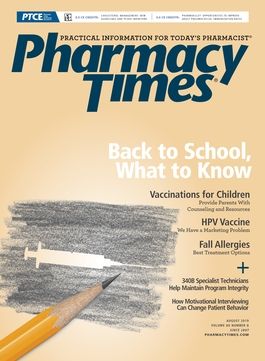Counsel Patients as They Head Into the Fall
Brown bagging is an essential educational and safety tool for those going back to school.
Brown bag consults can be essential educational and safety tools to measure and ensure quality care. By asking patients to bring in all their current medications, including OTC, mail-order, specialty, and herbal products, pharmacists can guarantee appropriate and up-to-date care.
Pharmacists are key providers in the continuum of care, consistently identifying potential problems and concerns that may require follow-up with prescribers or a medication therapy management (MTM) session. It is essential that a pharmacist’s workflow allow for brown bag consults, which can do the following:
- Develop the pharmacist—patient relationship to help create better individualized service, forge patient loyalty and trust, and prevent medical errors
- Provide insight into a patient’s lifestyle and quality of care
- Show how well patients understand their condi- tions and medications
Offering to review medications one-on-one gives pharmacists the opportunity to connect with patients by serving as trusted medical professionals in the community. Brown bag sessions do not have to be time-consuming scheduled events. They can be offered anytime a pharmacist thinks that a patient needs follow-up care after a typical counseling session.
Patients should weave preventive health care into every aspect of their lives, as it paves the way for better outcomes and quality of life. By being active, eating healthier, maintaining a healthy environment, and staying on top of wellness screenings, individuals can be their best self. The community pharmacy is a hub for preventive care and services. Pharmacists can play a big role in keeping patients safe and helping them identify conditions early, potentially preventing hospitalizations and unnecessary doctor visits. Pharmacists can also offer vaccines, screenings, and services, such as MTM, that can reduce costs.
GB is a 22-year-old woman who is a regular customer at the pharmacy. She is a new teacher’s aide at an elementary school in the area, and her roommate is a teacher at the local middle school. GB stops in to pick up her refill prescriptions. School has started again, and you notice that she is blowing her nose and coughing. You counsel GB on the medication refills and explain the concept behind brown bag and MTM sessions. You are actively trying to do more comprehensive medication reviews and stress the value behind preventive services that the pharmacy offers. You tell GB that because she has allergies, suffers from asthma, and works in a risky environment, she is an ideal candidate to participate in a brief review. You ask whether she would be interested in bringing in all her medications and going over them with you for proper use. GB says that because she is not feeling well, she would be happy to meet the next day, after she gets some rest. She sets up an appointment for when you have overlap time.
To prepare for the session, you pull up GB’s active pharmacy profile so you can compare it with what is in her brown bag.
Here is what you find:
- Albuterol inhaler, 1 to 2 puffs every 4 to 6 hours, as needed
- Fluticasone propionate, 250 μg/salmeterol 50-μg diskus, twice daily
- Norgestimate/estradiol tablets (Ortho Tri-CyclenLo), once daily
- OTC esomeprazole, 40 mg, daily
- OTC ibuprofen, 600 mg every 6 to 8 hours, as needed for pain
- OTC multivitamin, daily
When GB arrives, she empties her brown bag, and you notice these additional medications:
- Adult multivitamin with iron, once daily uAmoxicillin/clavulanate 875 mg/125 mg, every 12 hours for 7 days (filled 4 months ago at a competitor pharmacy, 4 pills remaining)
- Azithromycin, 500 mg, daily for 3 days (filled 2 months ago, 1 pill remaining)
- OTC brand Advil (ibuprofen), 200 mg, as needed
- OTC cetirizine, 5 mg/pseudoephedrine 120 mg, every 12 hours as needed
- OTC famotidine, 20 mg, twice daily u OTC omeprazole, 20 mg, once daily
After you review the medications for accuracy and adherence, GB mentions her new-onset headache and throat pain and her difficulty swallowing. You say that the pharmacy has a nurse practitioner (NP) on staff, and you recommend that GB make a drop-in appointment after the counseling session. Because GB has a history of sinus infections and strep throat, she should get proper attention and testing. Meanwhile, she says that the medications in her bag provide only temporary relief and quality of life is not ideal, as she wants to be energetic and happy around her students. Yet when you ask GB whether she takes her medications as prescribed or whether she asks enough questions about how to use them, she says she does not, as she is often in a hurry. You ask about her goals, and she says she does not want to be sick, miss school, or get her roommate sick. You suggest that GB come to the pharmacy for an MTM session when she has time so she does not feel rushed. You also find out that she has never received an annual flu shot, nor is she up-to-date on her vaccinations. GB does have a primary care physician but explains that getting an appointment is hard, and she has a high insurance deductible. Because of your brown bag session, GB is interested in participating in the MTM session you offered, after she sees the pharmacy NP to further investigate her concerns and issues.
What additional counseling would you offer GB?
Jill Drury, PharmD, is a clinical pharmacy specialist in Chicago, Illinois, and Milwaukee, Wisconsin.

